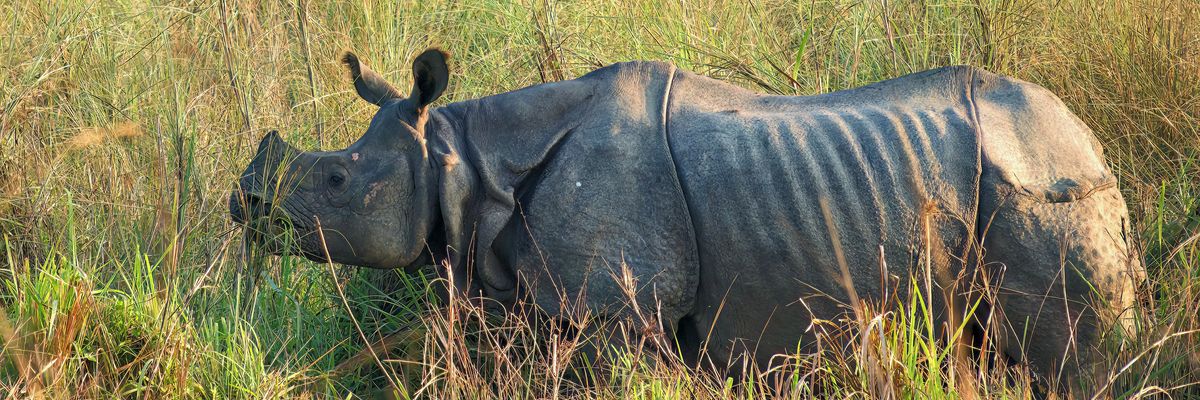People living around Koshi Tappu Wildlife Reserve in eastern Nepal are preparing to welcome two very special guests on World Tourism Day, Sept. 27.
Pushpa and Anjali are greater one-horned rhinos (Rhinoceros unicornis) who are being moved here from Chitwan National Park in central Nepal. The translocation of the two female rhinos is aimed at boosting the tourism potential and biodiversity of the eastern Terai Arc region that runs across southern Nepal and northern India.
“We will be translocating two rhinos to Koshi Tappu Wildlife Reserve on the occasion of World Tourism Day,” Hari Bhadra Acharya, acting director-general at the Department of National Parks and Wildlife Conservation told Mongabay. Although Acharya said they were yet to decide which pair will be translocated, department sources told Mongabay that Pushpa and Anjali have been chosen for the purpose.
The rhinos were rescued as calves in 2019 and 2020 after being abandoned by their mothers, and cared for since then at a rehabilitation center outside Chitwan run by the National Trust for Nature Conservation, a semi-governmental body. They will be the first of their species to inhabit Koshi Tappu.
"The park, which has no rhinos at present, offers a suitable habitat and less human disturbance for the rhinos."
The pair had previously this year been released into the wild in Chitwan, to the dismay of local residents and conservationists. They said the animals, which are habituated to humans, pose a risk to themselves and to people, and urged officials to relocate them as soon as possible
A move to Koshi Tappu was one of the original options officials had considered prior to the rhinos’ release, along with possibly gifting them to foreign countries as a form of “rhino diplomacy,” much the same way China hands out pandas to other countries. Koshi Tappu, unlike Chitwan, doesn’t have any tigers, which would make the reserve a safer place for the young rhinos.
“The decision to translocate rhinos to Koshi Tappu National Park was made after considering their conservation value,” said Acharya. “The park, which has no rhinos at present, offers a suitable habitat and less human disturbance for the rhinos.”
According to Nepal’s 2021 rhino census, Chitwan National Park is home to 694 rhinos, Bardiya National Park in the west has 38, Shuklaphanta National Park, also in the west, has 17, and Parsa National Park, adjacent to Chitwan, has three.
The planned translocation Pushpa and Anjali, carried out with the support of the NTNC, is also a part of the government’s long-term plan to create multiple viable populations of the vulnerable species in Nepal. For their move, the rhinos will be sedated and transported by truck, according to Acharya.
As with its tigers, Nepal has been successful in conserving its rhinos, achieving zero poaching for several years running now and growing the population from a low of 100 in 1966 to 752 in 2021. Translocations have been part of the conservation strategy during this period, beginning with the first batch of 13 rhinos moved from Chitwan to Bardiya in 1986.
This translocation is just a start, with more rhinos set to be moved to Koshi Tappu based on how the translocated pair adapt.
"We hope that the [latest] translocation will not only enhance the conservation of the species, but also attract more tourists and visitors to Koshi Tappu,” Acharya said, noting that the wildlife reserve, which is also a Ramsar site — a key wetland — and an important bird habitat.
Residents living near the reserve have awaited the arrival of rhinos there since 2017. That year, 15 wild water buffalo (Bubalus arnee) from Koshi Tappu were moved to Chitwan, with officials promising to bring over rhinos in return. However, the buffalo translocation wasn’t successful, with the animals all dying for various reasons shortly after their arrival in Chitwan.
Nepali conservationists have long pushed for the translocation of animals to take place at scale so that newly established populations survive in new habitats. Translocating two female rhinos to Koshi Tappu, where they won’t be able to breed to produce offspring, doesn’t serve a conservation purpose, they argue. However, Acharya said this translocation is just a start, with more rhinos set to be moved to Koshi Tappu based on how the translocated pair adapt.
